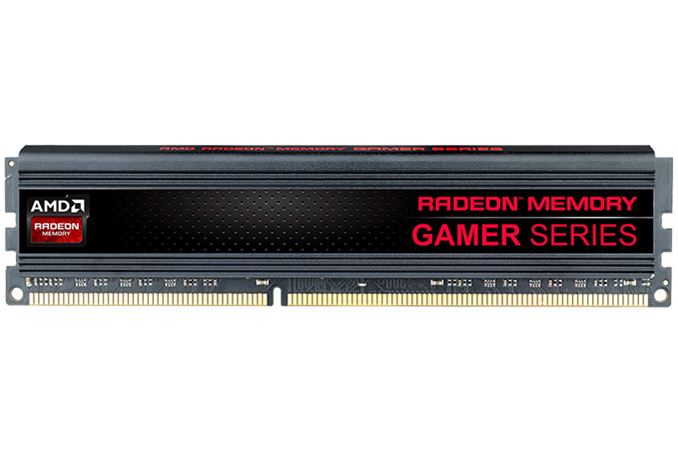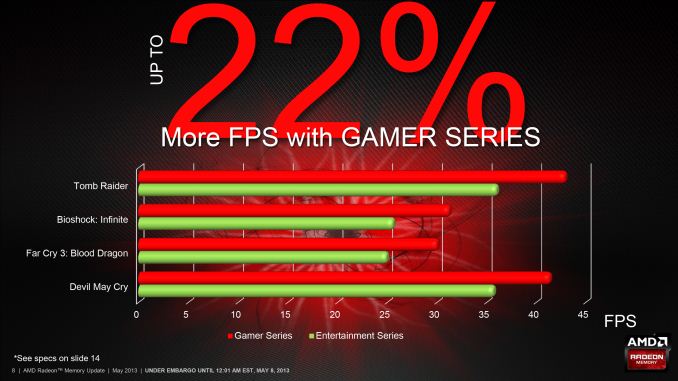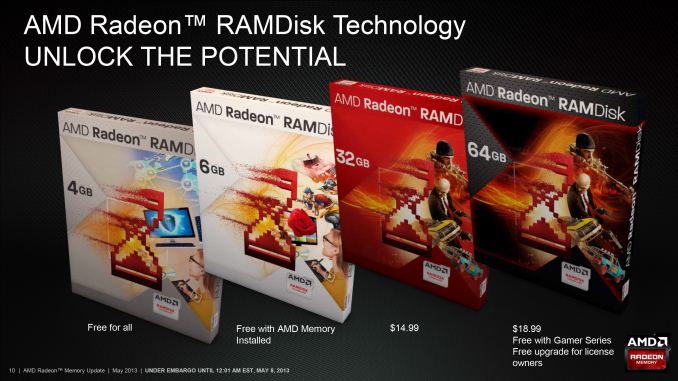AMD Releases New Radeon Memory SKU: RG2133 Gamer Series
by Ryan Smith on May 8, 2013 12:01 AM EST
After entering the PC memory market about a year and a half ago, things have for the most part been quiet for AMD’s fledgling memory operations. With DDR3 enjoying a long, prosperous reign as the memory of choice for PCs, memory is not a fast-moving field that has the kind of rapid innovation and quick product turnovers as AMD’s GPU and CPU businesses do. But with that said, even as a commodity product there’s still periodic bumps in capacity and performance, and that’s what AMD is announcing today.
Joining AMD’s existing 1600MHz (RE1600) and 1866MHz (RP1866) Radeon Memory products today is a new SKU, the 2133MHz (RG2133) Gamer Series. The RG2133 is a middle of the road 2133MHz part, sporting a CAS 10 latency (10-11-11-30) and a voltage of 1.65v. In keeping with AMD’s other memory products they aren’t using any flamboyant heatsinks here, so these are simple DIMMs enclosed in a heatspreader, keeping the DIMM height at a low profile of 30mm.
| AMD Memory Specification Comparison | |||
| RE1600 | RP1866 | RG2133 | |
| Kit Speed | 1600MHz | 1866MHz | 2133MHz |
| Subtimings | 9-9-9-28 | 9-10-9-27 | 10-11-11-30 |
| Voltage | 1.5v | 1.5v | 1.65v |
| Size | 2 x 8GB | 2 x 8GB | 4 x 4GB |
| Price | $95 | $125 | $155 |
As with AMD’s other memory products RG2133 memory is being manufactured and sold in 16GB kit form. The DIMMs are 4GB each – unlike AMD’s other speed grades which are 8GB these days – so the full 16GB kit is 4x4GB rather than 2x8GB. Meanwhile AMD continues to contract out the actual manufacturing of their memory products, and while they haven’t named the manufacturer of the RG2133 DIMMs they’ve said that they’re keeping the same manufacturer as with their other products, which would mean it’s once again Patriot doing AMD’s manufacturing.
For AMD the primary benefit of introducing another speed grade of RAM is not only to keep themselves competitive in the memory market, but also to work the fact that AMD’s APUs greatly benefit from increased memory bandwidth. Even though the GPUs in AMD’s APUs are lower performing than AMD’s discrete GPUs they’re still memory bandwidth starved to a very large degree, and as we’ve seen even back in 2011 with Llano most games benefit from additional memory bandwidth. So by pairing RG2133 memory with Trinity/Richland, AMD can significantly improve their GPU performance in many cases even with the same silicon.
The catch as always will be pricing. 2133MHz memory carries a distinct premium, so although faster memory will improve gaming performance it’s not a “free” upgrade. Builders and buyers will be looking at a $155 price tag for a 16GB RG2133 kit, $30 more than the RP1866 kit. However short of adding a discrete GPU, this is going to be the best way of improving AMD’s iGPU performance for the time being.
On a final note, AMD will once more be bundling licenses for their branded version of Dataram’s RAMDisk software with their memory. RG2133 kits will come with a license good for a 64GB RAM disk (note that you can’t actually get 64GB of RG2133 into a system at the moment). All other AMD memory products will continue to ship with a license for a 6GB RAM disk. The usefulness of AMD’s RAMDisk software remains questionable, but as AMD’s pricing is generally competitive it’s essentially a freebie with an otherwise solid memory package.












23 Comments
View All Comments
Azethoth - Wednesday, May 8, 2013 - link
1) Ramdisk? Wth? Ramdisks are dumb in the age of a modern OS. Sacrifice a bunch of RAM that can then not be used in the regular virtual paging scheme is the epitome of "I just do not have a clue". Unlock the potential to cripple my system? Sign me not up.2) Why do my expensive Radeon HD 7970's from Diamond and XFX not support Windows 8 secure boot? That seems like it would be a better thing to spend money on than developing RAM that was too slow already a year ago when I got 32GB of 2400 MHz kit for my new Asus board + Ivy Bridge system at the exact same cost / Gb as this inadequate stuff. Slower RAM does not help me. Fast and secure boot would.
Bob Todd - Wednesday, May 8, 2013 - link
To be fair about the cost/GB, RAM prices have at least doubled in the last few months. I bought several kits of 1600 for $25 and 1866 for $30 around the holidays. Those exact same kits are $66 and $69 dollars right now respectively.Kevin G - Wednesday, May 8, 2013 - link
Depends on the RAM. Two months ago picked up 128 GB of registered ECC memory for under a $1000. Prices have only increased by $5 per DIMM so it'd be a hair over $1000 now.Bob Todd - Wednesday, May 8, 2013 - link
Very true. I should have specified consumer stuff. From what I read a while back, the big 4 had all drastically cut commodity DRAM output to focus that capacity on enterprise and mobile. So your experience seems to validate that.arthur449 - Wednesday, May 8, 2013 - link
Negative. In the days of 32-bit console ports and MMOs with increasingly large data sets trying to maintain compatibility with the ancient XP, a RAM disk is very USFL at manually caching the game assets since the developers are unwilling to maintain two separate codebases. This is particularly a problem with SWTOR where zoning times to some planets is measured in minutes on a fast system with two SSDs in RAID0.The fact is, most games aren't programmed flawlessly or particularly well. Again, to use SWTOR as an example, it copied all zone data not into memory when loading, but instead into a temporary multi-gigabyte 'arenacache' file on disk. This was particularly unhealthy for SSDs, which are vulnerable to longevity problems when a game writes more than 20gb of data to disk every play session, as it did when I was still playing. For that game, and I'd imagine others, 32gb of cheap memory and learning how to use imdisk made my play experience better and saved my expensive SSDs some unnecessary wear.
Sorry for typos, typed on my phone.
Azethoth - Wednesday, May 8, 2013 - link
Well there you go folks. You can use RAM disks to force bad programs to not kill your SSD! I stand corrected. Yikes.Zan Lynx - Wednesday, May 8, 2013 - link
This "arenacache" thing is exactly what happens in large programming environments. The engine team says "This data file format is really slow and inefficient. We want to fix it." And the asset team says, "We can't change it. All our tools write in this format. Get stuffed." And so the engine team, needing to load things quickly from hard drives because gamers don't have 20GB of RAM, have to copy and reformat all the game assets into their own, actually useful format.You may be able to tell I have a lot of sympathy for the software engineers who actually want things to be fast and efficient.
Flunk - Wednesday, May 8, 2013 - link
Realistically, we all could afford to have 32GB of RAM. It's so cheap these days. We just don't need it because things are still written for 32bit XP junkers.arthur449 - Wednesday, May 8, 2013 - link
I have sympathy for them as well. The problem is this cowardly attempt to maintain backwards compatibility with a 9-year old (WinXP SP2 = Win2003) 32-bit OS instead of making a stand and using the popularity of SWTOR (which many of my friends built new systems for in anticipation) to drive adoption of 64-bit systems where memory management is less of a headache.I'm going to be original and just blame EA.
gevorg - Wednesday, May 8, 2013 - link
There is still great use for RAMDisk, such as a cache folder for your browser (especially Chrome). Not necessarily for speed gains, but to alleviate high I/O from SSD/HD to RAM and prolong its life.